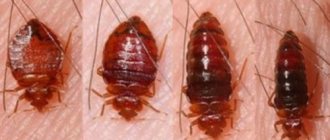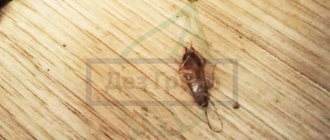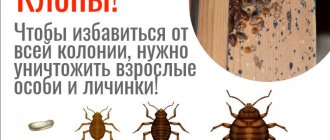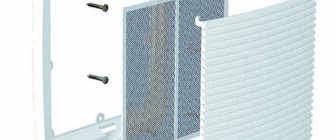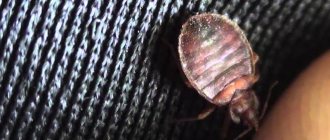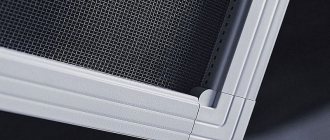- By Vil Malinoshevsky
- About bedbugs
Look at the photo below. These are bed bugs:
Two adults (brown below) and several nymphs of different ages and therefore different sizes are visible here.
This is what bed bugs look like. They are small brown insects, some translucent, yellowish, but all without wings, with a wide, squat body and clearly visible transverse constrictions across the abdomen.
Looking at this photo, it seems that recognizing bed bugs in normal home conditions somewhere in an apartment will be very easy. But our practice shows that this is not at all the case.
It seems that almost every person today can go to the Internet, find a photo of a bedbug, compare with it the insect that he finds in the apartment, and understand whether it is a bedbug or not. But in reality, we are faced with a huge number of situations when people call us, call an exterminator, but cannot say for sure whether they have bedbugs or not. We arrive and usually find that it is bedbugs. Or, on the contrary, it happens that a person panics when he finds an insect on the bed (especially on a child’s bed), he is afraid that bedbugs will bite him, but in reality it turns out that the discovered insect is a beetle grinder, or a skin beetle larva.
On the left is a skin beetle larva, on the right is an adult beetle.
There are also funny cases. For example, once we were sent a photo of a supposed “bug” for identification, but in the photo we found a very exotic pretend beetle. It turned out that he was photographed in New York, but because of his very original appearance, they decided that it was a bedbug.
The same spider beetle from the family of pretenders
In general, even if you have a photo of a bedbug at hand, it is not always possible to find out for sure whether there are bedbugs in a particular apartment. Perhaps this is due to the fact that in the photo the bedbugs are shown in close-up, but in reality they are small and it is difficult to see the details of their structure. Perhaps the smallest larvae are barely visible to the naked eye, and comparing them with a high-quality photo will be problematic.
But in any case, knowing what bed bugs look like, in most cases they can be recognized. Therefore, now we will show good photographs of them and explain what details you need to pay special attention to in order to understand exactly what these parasites are in front of you.
Let's start with the basics...
Adult bed bugs in the photo
Bed bug imagoes, that is, adults, are the most easily recognized. This is how they look on the sofa upholstery:
Please note that their body color is dark brown. The size of such an adult bug is approximately 4-5 mm in length, 3-4 mm in width.
A bug that has just sucked blood has a burgundy-red abdomen, since the covers of its body are translucent and the blood itself is visible through them. The photo below shows such a well-fed parasite:
And here on the left is a bug before blood-sucking, and on the right after saturation:
Feel the difference…
In most individuals, within a day or two after saturation, the blood is digested and only a small black spot of irregular shape is visible on the body:
This spot of semi-digested blood is even better visible in nymphs with their thinner and more transparent body coverings:
Adult bedbugs differ from nymphs in size and darker body color. For example, in this photo there is an adult bug and several nymphs:
Please note: none of the specimens have wings. This is a distinctive feature of bed bugs: due to the specifics of their lifestyle, they have lost their wings, which they do not need, for maximum flattening of the body and the ability to hide in the narrowest crevices. From the wings that the ancestors of these insects had, bed bugs only have small rudiments left on the pronotum:
Another interesting fact is that bed bugs make up an entire family with about 100 species. Of these, Cimex lecturarius is most often found in human housing, but sometimes Cimex hemipterus is also found here. The first is distributed throughout the world, the second - mainly in the tropics. Moreover, Cimex hemipterus has more hairs on its body than Cimex lecturarius.
The photo here shows Cimex lecturarius, the most domestic of bed bugs:
And here is Cimex hemipterus:
And this is what the imago of the species Cimex pipistrelli, which parasitizes bats, looks like:
Here, by the way, he is photographed on the wing of a bat
That is, in real conditions it is almost impossible to determine the type of bed bug with the naked eye.
Moreover, even from representatives of other genera, an ordinary bed bug can only be distinguished under a microscope and with certain knowledge. For example, here in the photo is the swallow bug Oeciacus hirundinis:
Agree, it is also identical in appearance to the indoor Cimex lecturarius.
But distinguishing a female from a male in this species is quite simple. Females have a wider and more rounded body, while males have a small protrusion at the end of the abdomen with a copulatory organ, turned to one side. Externally, it creates the impression of asymmetry.
Here in the photo on the left is a male, on the right is a female bedbug:
And here are two males, only the one on the left is hungrier, and his body is lighter:
In nymphs, even the last instars, there are no visible differences between females and males due to the underdevelopment of the reproductive system.
By the way, photos of nymphs are no less interesting...
What does body size depend on?
The main factor influencing the parameters of the insect is the feeding intensity. The digestive system is capable of accepting a fairly large volume of food. As a result, bed bugs' body size changes significantly by 2-3 times. Because of this, it is not always possible to recognize bed bugs. This feature is observed in bed, household, and linen parasites (different names for representatives of this species).
Herbivores and predators do not have the ability to grow so much.
What size do adult house bugs reach?
The body parameters of different insects differ. For example, the triatomine bug, smoothie, is considered the largest. Body length will vary from 15 to 35 mm. To understand how big these insects are, you need to know how big bed bugs are. So, adult individuals reach 6-8 mm. This difference is due to differences in gender. Thus, the body size of female bedbugs often reaches 8 mm.
The body length of an adult bedbug can reach up to 8 mm
Table: bed bug sizes at different stages of development
To understand who attacked at night (nymph, adult), insects at different stages of development should be compared in size. The table shows all possible parasite parameters, including their nest.
| Stages of insect development | Dimensions, mm |
| Egg | No more than 1 |
| Larva (1 week of development after emerging from the shell) | 1 |
| Nymph (at different stages) | 1,5-3 |
| Imago | 4-8 |
| Adult parasites after eating | 10-15 |
| Nest | 50-100 or more |
Bedbugs do not create nests. They gather in colonies. If the vital activity of bed bugs is being studied, the size of their habitat should also be known in order to understand what to expect when searching for insect refuge. Thus, the size of the “nest” of parasites can be completely different. While there are few furniture insects at home, they gather in small groups.
The female lays up to 5 eggs per day, and therefore the size of the colony increases gradually. After a few weeks, the size of the nest can be 5 cm (in diameter, but the shape is often irregular, and therefore the parameters are approximate). The more bedbugs there are, as well as the larger the habitat in the apartment, the more numerous the colony will be in each area.
In the worst case, the nest will not look very pleasant: it is a large spot formed by numerous insects, their offspring, excrement, and husks from chitinous shells. Sometimes such formations grow to frightening proportions.
A group of bedbugs on the leg of a sofa
What do nymphs of different ages look like?
Nymphs are bedbug larvae. Like other insects with incomplete metamorphosis, they are similar in appearance to adult bedbugs, have a similar body structure, lead the same lifestyle and feed on the same food - human blood. Their differences from adult individuals are in size and color, as well as in the underdevelopment of some organ systems, in particular the reproductive one.
This is what a first instar nymph looks like, having just left the egg:
And this is a nymph before the last molt, after which she will enter adulthood:
As we see in the photo, nymphs have yellowish translucent body covers at all stages of their development. Droplets of blood pumped from a person are especially clearly visible through them.
In the video below you can see how the nymph feeds and how, when sucking blood, blood literally flows into her stomach:
After saturation, the nymphs become bright red, looking like running droplets of blood:
The nymphs of the first instar bedbugs are very small; they cannot even always be seen on the bed. But the nymphs of the last instars are already comparable in size to adults.
The photo below shows nymphs of all ages next to an egg and an adult bug:
During its development, the nymph molts 4-5 times, increasing in size after each molt. Within half an hour to an hour after shedding the old body covers, the new cuticle of the larva is very soft and almost white, translucent. Seeing such an individual on a bed or on a sofa, you might even think that such a white bug is a representative of some other species. For example, here is a just-molted “baby”:
It is these nymphs, especially the smallest ones, that people most often do not consider bed bugs and try to find out what kind of insects they are. We came across different cases: once students told us on the phone that these were probably some spiders that had multiplied on the mattress. Another time we showed these larvae to an old grandmother in an infested apartment, and she swore that we, apparently, were not exterminators at all, because we didn’t know what bed bugs looked like, but she knew that they were round and brown...
Where do bedbugs come from in the house?
When a person has bedbugs in his home, he immediately has many questions. Where and why, what kind of species, how dangerous they are and how to get rid of them. First, let's talk about where bedbugs can come from in an apartment. So, first of all, it is worth noting that no one is safe from the appearance of bedbugs in an apartment .
And it doesn’t matter how clean your place is or how often you take out the trash. The main thing for these unpleasant bloodsuckers is the availability of food and warmth. Therefore, an apartment of antisocial elements and a fashionable hotel can become a refuge for them equally successfully. Moreover, in places with large crowds of people and a large number of premises, it is much more difficult to cope with bedbugs , since they can migrate.
For quite a long time there was a belief that bedbugs in the house are caused by dirt, but this is not true. Any entomologist will tell you that insects cannot materialize into a home, which is called “out of thin air.” This means there are ways for them to penetrate into housing. Let's talk about them.
There are many reasons for the appearance of bedbugs in the house, and you can read about this in detail in a separate article. In the meantime, we will list the most basic ways bedbugs enter human housing:
- Natural migration. The multiplied population penetrates into neighboring premises through ventilation systems, pipe risers and other communications.
- A person brings insects or larvae himself, having been in an infected room, on his clothes or in his luggage.
- Purchasing furniture and other items that have been used and are infested with parasites.
Sometimes, when purchasing a home, you may not notice the presence of bedbugs in it, since they have the ability to fall into suspended animation and become active when food sources appear.
To understand even better what bedbugs are and how to deal with them, you can learn more about the stages of development of parasites and the signs of their presence in an apartment in separate articles on our website.
Several photos of bed bug eggs
Due to their small size, bed bug eggs are difficult to find and see indoors. Moreover, they are white and blend in with the upholstery of the sofa, the color of the wallpaper or bed linen, on which they can be placed.
Enlarged, they look like this:
The larvae have not yet hatched from these eggs.
This photo clearly shows that the eggs have a specific cup-shaped shape. At the top of the egg there is a flat “lid”, which the larva discards when hatching and climbs out.
By the way, under a microscope or with good vision and the naked eye, you can distinguish an egg with an embryo from an empty shell from which the nymph has already hatched.
Here in the photo on the left is the empty shell of the egg from which the nymph hatched, on the right is the egg in which the embryo develops:
The second egg is dull white and opaque because the embryo is tightly packed inside it. This is what eggs with embryos look like:
It can be seen that they are opaque. And in this photo there are close-ups of empty egg shells:
It is clearly visible that they are translucent, and the “hats” are open in the upper part.
Directly on furniture and in various bedbug hiding places, the eggs look like grains of long-grain rice. Interestingly, they stick with the bottom to the surface, and therefore it is impossible to simply brush them off.
As a rule, in an apartment, bedbug eggs are found in clusters on furniture, since females lay them in the quietest suitable places, where they themselves gather in large quantities. Moreover, such accumulations even in photographs look creepy, and one can only guess what an unprepared person who looks at such masonry on his sofa experiences. For example:
Or a cluster like this:
But, as a rule, eggs themselves are not found either in clusters or individually. Usually they are found together with bedbugs, their larvae and all accompanying waste products in those places where bedbugs hide during the day and which are not entirely correctly called nests.
Causes of house bugs
The reasons for the appearance of house bugs may be that:
- Bedbugs lived indoors before you arrived
- Bed bugs live somewhere in the public areas of the house and from there they crawl towards you
- You accidentally brought parasites into the house on something or on yourself
Insects are often found where there are unsanitary conditions, but they themselves are not critical for the pest, so in fact, bedbugs can appear in absolutely any home, regardless of the financial well-being or social status of its owners or tenants.
Bedbug nests in the photo
Actually, bedbugs do not form organized nests like wasps and especially ants. They simply hide during the day in the most suitable places, and since there are much fewer such places in the room than there are bedbugs themselves, these parasites can accumulate in huge quantities in the most comfortable shelters. In these places there are the bugs themselves, both adults and nymphs of all ages, eggs, remains of the chitinous covers of the larvae, excrement, and in general they look very unpleasant.
For example, here is a typical bedbug nest on a sofa upholstery:
And here the video shows the same accumulation, only on a blanket, which is generally atypical for bedbugs - they prefer to settle on stationary surfaces that are not disturbed by people:
Here is another place for bedbugs to hide, rest and breed, which completely covered one side of the mattress on the bed:
The largest such “nest” that we saw caught the eye of exterminator Kostya in an apartment near Moscow - it was about 80 cm in diameter and was located in the sofa. It is difficult to say how many parasites there were in it, but the sight was, to put it mildly, repulsive.
By the way, this is what a cluster of small larvae looks like right on the mattress:
It was precisely these young individuals that the students we have already mentioned mistook for some strange spiders. But they were definitely sure that these were not bedbugs.
Such hiding places cannot be called nests, because there is no organization or order in them. For example, in the nests of wasps, termites or ants, strict order reigns: the queen lays eggs, the workers look after her, the brood, the nest itself, obtain food, and protect the nest from enemies. All this is not present in bedbug clusters:
- There is no queen that lays eggs alone - all adult females lay them;
- There are no individuals who would maintain order here - everything in such a shelter accumulates spontaneously, complete disorder reigns here;
- The nest is not protected in any way by anyone, and when it is opened, some of the bugs try to run away, the other part hides, hoping that they will not be noticed;
- There is no hierarchy in such a cluster. Bedbugs simply accumulate here, spend daylight hours here, reproduce and die here.
By the way, you have probably already noticed that almost everywhere in such places of accumulation you can see black dots that look like balls. You probably already guessed what it is...
Stinging bug
This is a close cousin of the bed bug. Few are able to distinguish them with the naked eye, because even in appearance they are very similar to each other. However, the stinging bug is more dangerous to humans. Traces from stinging bug bites are more pronounced: redness can reach 5 centimeters in diameter and take the form of large blisters. This is accompanied by severe itching, which is an acute allergic reaction similar to hives. This type of bedbug is also different in that it moves much slower than a bedbug.
Bed bug excrement as obvious traces of their presence in the apartment
Yes, yes, this is exactly excrement, in common parlance – “poop”. This is what they look like close up:
And so - in the general photo of the nest:
They are black, in places where they accumulate, they are usually already dry and simply crumble when crushed. When fresh, they smudge and form ink blots that cannot be washed off with water. By the way, they may contain pathogens of dangerous diseases, and accidentally rubbing the contents of such feces into the skin is the only way to become infected with anything from bedbugs.
In the morning, by the way, such stains from them can be found on the body if such feces are smeared on the skin at night.
Very often, without even knowing that bedbugs live in the room, people find such excrement in the dust when cleaning and do not even think about what it is. So, know that these are waste products of bed bugs:
By the way, they are one of the most noticeable and first visible signs of the presence of bedbugs in a room. After bedbug bites on the body, of course...
How to get rid of house bugs
There are 4 main directions in the fight against bedbugs. Three of them involve the direct destruction of parasites, the fourth approach is preventive measures that are relevant regardless of how exactly you decide to get rid of bedbugs.
Folk remedies
Most traditional methods repel or reduce the activity of bedbugs due to their strong and unpleasant odor. It is impossible to get rid of the entire colony in this way. When choosing a product from this category, adequately assess how justified its use is. Kerosene, turpentine, gasoline and other flammable oily liquids often recommended in the fight against bedbugs can do more harm than good. There are more modern, safer and, at the same time, inexpensive products on sale.
Insecticides for self-use
Insecticides for controlling bedbugs are most often produced in the form of aerosols, sprays, concentrates and, less commonly, powders. Aerosols and sprays are completely ready for use and are ideal for local treatment. If you need disinfestation of the entire apartment, you can use concentrates. Before use, they must be diluted in water and poured into a spray bottle. When processing, you definitely need a full set of protection: closed clothing, gloves, a respirator, an eye mask. Powders are the least popular because they simply need to be scattered in bedbug habitats, which creates extra dirt and is also dangerous if you have children and pets.
Professional processing
Disinsection against bedbugs
– this is the fastest, most effective and safest way for you to get rid of bedbugs. Treatment with individually selected expert-level products using hot and cold fog methods is carried out in just 1 day, and the result is guaranteed under a contract from 1 to 3 years, depending on the method of work.
Calculator
Calculate the cost of exterminating insects in the house
Number of rooms:
(Cold fog)
(Cold Fog + Barrier Defense)
(Hot fog + Premium drugs + Barrier protection)
(Hot fog + VIP drugs + Barrier protection)
Total cost: 01
Order processing
Preventive measures
Preventive measures mostly include housework, which are not directly related to the physical destruction of bedbugs, but have a dramatic effect on the effectiveness of any treatment method. These include cosmetic or major renovations, installing mosquito screens on windows, sealing cracks and much more. If you use at least part of these recommendations
, you will greatly reduce the likelihood of any insects appearing in the house.
What do bed bug bites look like?
The consequences of bedbug bites on the body are usually the first detectable sign of the presence of these parasites in the apartment. Due to the fact that bedbugs hide well, they almost never catch your eye by accident, but if a person has a strong reaction to the bites, then the next morning after the bites he discovers the following redness on his body:
Or these:
Sometimes they are even found on the face:
As a rule, in the early stages of infection of an apartment, these swellings are few in number and sometimes do not attract attention at all - the person thinks that he was bitten by a mosquito or just some pimple popped up. And only when such bites begin to appear regularly and their number begins to constantly grow, does the bitten person begin to suspect the constant presence of some bloodsuckers in the apartment.
The worst photographs of bedbug bites, as a rule, do not reflect the typical picture. For example, like this:
It happens extremely rarely when a person spends one night in a heavily contaminated room (for example, in a hotel in some outback). If a person has such a pronounced reaction to bedbug bites, then in his own home he will begin to feel them when there are 2-3 of them every night, and, accordingly, will take action before the parasites multiply in quantities capable of biting so strongly. Exceptions are rare - for example, if neighbors poisoned bedbugs and all these brethren rushed to run away to neighboring apartments, an invasion and severe bites may occur in one of these apartments.
By the way, many people do not feel bedbug bites at all, even when there are many such bites. For example, one of our volunteers checked his reaction to bites - there was no such reaction. Watch the video:
It is dangerous if there are people living behind your wall who also do not have such a reaction, and they have bedbugs. These neighbors simply won’t know that they have parasites living in their house, they will safely feed them without feeling it, the bedbugs will multiply, crawl into the neighbors’ premises and gradually get into yours.
On a note
According to statistics, the majority of such people who are not sensitive to bedbug bites are from 65 to 75%. This is the main reason that bedbugs still thrive near humans: most people simply do not suspect that they are feeding these parasites, and they happily reproduce next to their hosts.
There is no obvious relationship between a person’s gender or age and their sensitivity to bites. It happens that even small children or women with thin and seemingly sensitive skin do not have any bumps left on their bodies from bites. And it happens that tough grown men suffer greatly from these bumps, they develop severe symptoms, even generalized ones. It all depends on the individual reaction of the body to the components of bedbug saliva.
This is, for example, what a bitten man looks like with a very acute reaction to substances secreted by bedbugs:
This difference in sensitivity, by the way, often leads to the misconception that bedbugs indoors do not bite all people and somehow select them based on their blood type, age or gender. We dispelled this myth in a separate video:
The main feature of bed bug bites is that they form characteristic chains of 3-4 cones. For example, the following “paths” are visible in the photo:
And these:
Such “paths” of bites are left by adult bedbugs, each of which sucks blood from several wounds in one person in one night. The parasite pierces the skin, sucks blood, then removes its proboscis, moves 2-3 cm forward, makes a new puncture, sucks again - and so on 3-4 times. Its entire course turns out to be well marked with bumps from bites.
Young nymphs, as a rule, do not leave such “paths”, since the blood from one bite is enough for the insect to be completely saturated. And the spots at the site of their bites sometimes do not swell. Here, for example, small feeding nymphs are shown, and below is a spot at the site of the bite:
Therefore, in heavily infested apartments, bitten people have both individual bumps and bites connected in “chains” on their bodies.
As a rule, such bites go away on their own without special treatment. If they itch too much, you can lubricate them with a special ointment after Hector bites - it quickly soothes the itching, relieves redness and prevents secondary infection of the bite site with bacterial infections. If you don’t have Hector ointment on hand, you can lubricate the bites with Menovazin or other pain-relieving ointment. When the effect of the ointment is completed, the bites themselves will go away, or at least will not itch.
And, by the way, most other parasitic insects that can live next to a person in his home also do not leave such “paths”. This makes it quite easy to distinguish bedbugs from other bloodsuckers and simply harmful roommates in the apartment.
House bugs
The most unpleasant and unwanted insect that can appear in any home, regardless of the wealth and cleanliness of the household. In principle, a bed bug is a linen bug. It received this name because of its behavior and habitation. Since it prefers to hide in the folds of furniture, bedding and live in beds, closer to the power source.
There are several dozen existing types of house bugs. They are all similar in structure and behavior. But the type of bed bug can be distinguished by several characteristics. The body is flat, small, capable of increasing its size several times. The wings atrophied as unnecessary. Parasitic insects enter other apartments by “traveling” in furniture and suitcases.
In places where bedbugs accumulate there are a lot of remains of their vital activity: skins of chitinous shells, scales, excrement, egg shells, droplets of blood and simply dead bedbugs.
Different types of bedbugs in an apartment cause the same damage to the inhabitants of the home. Besides the fact that they feed on human blood and do not make concessions to anyone, it is a big misconception that bedbugs “love” someone more. It's just that different people react differently to bites. Some people get severe itching and crimson spots that swell and swell, while others may not even immediately notice small punctures on the skin.
The bed bug's closest relative is the stinging bug. Minor differences in the behavior of the insect allowed scientists to classify it as a separate species. It is slower and can jump when moving, apparently compensating for its low speed. Cold is destructive for it, so it can only be found in countries with a hot climate. When changing from southern to northern latitude, it quickly dies.
It bites more painfully, which is why it is hot. The person gets an allergic reaction, like hives. The itching is unbearable, which forces you to scratch the bite sites, further injuring the skin.
Perhaps the most dangerous type of bedbugs lives in Latin America. This is an insect from the family of predators. Its bite is dangerous due to the developing allergic reaction that threatens anaphylactic shock.
The triatomine bug bites humans mainly at night, when the “victim” is sleeping. The insect's saliva may contain an infection called Chagas disease, which is caused by protozoa. This disease is fatal, for which there is still no cure.
The world of insects is much more interesting than it might seem. The number of some species reaches hundreds and amazes with their ability to adapt to the surrounding world.
Even bugs are represented by so many insects that are divided into large groups, some of which are capable of helping humans, preserving and increasing crops, and conducting “invisible” pest control in the garden and in greenhouses. Others simply lead a parasitic lifestyle, not only feeding on human blood, but also damaging furniture, mattresses and sofas.
The ability to use modern methods and chemicals to combat parasites greatly simplifies human life. Using other bugs as biological weapons against pests is a new modern approach to growing crops.
We distinguish bedbugs, fleas, ticks and lice from photos
It is enough to see bedbugs and other synanthropic insects next to each other once, so that later, when you encounter them in an apartment, you will never make a mistake with identification.
For example, here the photo shows a bug next to two red cockroaches:
On the left is an adult bedbug, in the center is a Prussian nymph, on the right is an adult red cockroach. It can be seen that even small red cockroaches are larger than an adult bug. Cockroaches also have a slimmer, elongated body, and adults have wings, which bedbugs do not have. But the most reliable difference is the presence of cerci at the end of the abdomen in cockroaches - two outgrowths similar to short antennae. Bedbugs don't have them.
And here is a bedbug next to two black cockroaches, also a nymph (middle) and an adult female (right):
In principle, it can be confused with a nymph due to the similarity in size and color.
In any case, all cockroaches run much faster than bedbugs, and the big ones run so fast that sometimes you can’t even swat them. Bed bugs crawl much slower and it is not difficult to crush them.
And here in the photo on the left is a bedbug nymph, and on the right is an adult cat flea:
They are similar in size, but the bug is lighter in color, and its body seems to be flattened on top (although in nymphs this is not as noticeable as in adults). Fleas are darker, and their body, on the contrary, is laterally compressed.
But the main difference between these parasites is that fleas jump, while bedbugs cannot do this. Moreover, fleas jump so quickly that the jump is not noticeable at all: it seems that the parasite was just here, and now it has simply disappeared. If this happened, then it was a flea.
On a note
By the way, fleas can also sometimes bite several times during one feeding and leave chains of bites, but this happens very rarely.
People often ask us how to distinguish a bedbug from a tick. It is important to understand here that there are practically no cases when they really need to be distinguished for two reasons:
- There is some external resemblance between bed bugs and ixodid ticks (the same ones that can carry encephalitis and tick-borne borreliosis), but these parasites are not found nearby - ixodid ticks do not live in human homes, and bed bugs do not live in meadows and forests, where Ixodids are found. Simply put, you cannot find ixodid ticks in an apartment - they do not survive here. As an exception, it may happen that one of the people or a dog brings such a tick home and the parasite falls here. Below we will show how to understand that it is a tick and not a bug;
- So-called dust mites can constantly live in apartments, feeding on skin particles that are exfoliated from people. But it is, in principle, impossible to confuse them with bed bugs, since they cannot be seen with the naked eye: the body length of adult individuals is 0.3-0.4 mm, and due to the translucency of the integument, they are practically invisible in the dust and in the pile of carpets, where they usually live . Simply put, if you see any arthropod indoors, it is definitely not a dust mite.
This is what dust mites in a home carpet look like under a microscope:
They do not bite people and only harm people by excreting substances that are strong allergens in their excrement. It is believed that more than half of the cases of allergic rhinitis and bronchial asthma of unknown etiology in people are associated with an allergy to dust mite secretions. Moreover, ticks often settle in pillows and mattresses, excreting excrement in close proximity to the face of a sleeping person.
On a note
Dust mites are much more widespread than bed bugs - they are found in varying numbers in approximately 95% of households around the world.
That is, we found out: the only thing that can be confused with bedbugs is an ixodid tick that was accidentally brought from a walk. This is what these parasites look like next to each other:
On the left is a bug, on the right is a tick
All you have to do to tell them apart is count the legs. Bed bugs have 6 (3 pairs), ticks have 8 (4 pairs). If it turns out to be a tick, you can either kill it (which, by the way, is difficult - they have a very strong body), or throw it outside - there are no relatives in the room, since ixodid ticks do not reproduce here.
Finally, small bedbug nymphs can be confused with lice. Look at the photo - here on the left is a bedbug nymph, on the right is a head louse:
Their sizes are approximately comparable, but the louse is more slender and elongated in length. In addition, lice are found either on a person’s hair or on his underwear; if we are talking about pubic lice, then on the hair in the groin. It is almost impossible to find lice under a mattress, on a baseboard, or on furniture - due to their low mobility and inability to move on a smooth surface, they die here very quickly. Bedbugs, on the other hand, are not found in people's hair or underwear, since they are uncomfortable crawling there.
But an even more reliable difference between bedbugs and lice is that lice bite a person around the clock, since each individual must feed once every 3-4 hours. Bedbugs normally bite only at night.
Finally, if you come across an insect in your apartment that looks like a bedbug, only with wings, it could be an outdoor stink bug. Here's a comparison:
On the left is a bedbug, in the center is a green stink bug, on the right is a berry stink bug. The proportions in size are approximately preserved.
Such shield bugs do not bite people, but they stink strongly when frightened. It is better to catch such a find with a handkerchief and throw it out the window.
It is clear that there are other insects with which bedbugs, and especially their nymphs, can be confused. Ants, small spiders, grinder beetles—whatever clients send us in photographs so that we can help them figure out what exactly they found in their home. But such errors are rare and occur rarely.
How to destroy an individual while the size of the bedbug is small
The methods for controlling larvae are the same as for killing adults. In order to eliminate the problem of infestation in an apartment as quickly as possible, you should treat bed bugs with different means, and it is advisable to use them simultaneously
It is important to repeat all steps after 1-2 weeks, when a new generation of bedbugs appears. The protective shell prevents the destruction of parasites inside the eggs
Anna Biryukova, 34 years old, Moscow I have children at home, so I treated the apartment with a steam generator. We had to move a lot of furniture throughout all the rooms to open access to remote corners, baseboards, and back walls of cabinets. But the result justified such actions. There were no more parasites.
Veronika Kosareva, 39 years old, Perm I use insecticides. These products act quickly, however, I have a 1-room apartment, so I can easily treat all places. Then you need to do the cleaning, and after 2 weeks process again. After this, not a single parasite at home.
Herbs and essential oils
This method helps repel bedbugs. It is used to prevent bites. It is recommended to use herbs with bitterness: wormwood, tansy. They are laid out around the apartment in different places.
Essential oil does not kill bedbugs, but repels them
Temperature
Parasites die within 30 minutes if exposed to temperatures of +50°C. When the value of this parameter increases to +60°C, insects die instantly. The higher the temperature, the faster they die.
Bedbugs are very sensitive to ambient temperature
Steam generator
This is the most preferred processing method: safe, effective, convenient and helps to quickly get the desired result.
In fact, this is not steam, but tiny particles of liquid and insecticide.
Chemicals
They use natural insecticides - the pyrethrin group, as well as synthetic ones: pyrethroids, organophosphates, etc.
In modern times, there are a great variety of chemical insecticides against bedbugs.
